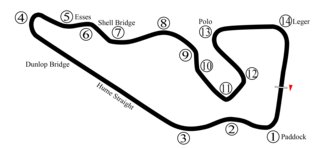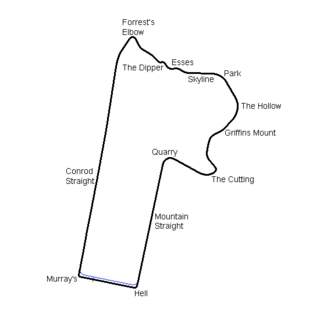
Tazio Giorgio Nuvolari was an Italian racing driver. He first raced motorcycles and then concentrated on sports cars and single-seaters. A resident of Mantua, he was known as 'Il Mantovano Volante' and nicknamed 'Nivola'. His victories—72 major races, 150 in all—included 24 Grands Prix, five Coppa Cianos, two Mille Miglias, two Targa Florios, two RAC Tourist Trophies, a Le Mans 24-hour race, and a European Championship in Grand Prix racing. Ferdinand Porsche called him "the greatest driver of the past, the present, and the future."

Raymond Sommer was a French motor racing driver. He raced both before and after WWII with some success, particularly in endurance racing. He won the 24 Hours of Le Mans endurance race in both 1932 and 1933, and although he did not reach the finishing line in any subsequent appearance at the Le Mans, he did lead each event until 1938. Sommer was also competitive at the highest level in Grand Prix motor racing, but did not win a race. He won the French Grand Prix in 1936, but the event that year was run as a sports car race. After racing resumed in the late 1940s, Sommer again won a number of sports car and minor Grand Prix events, and finished in fourth place in the 1950 Monaco Grand Prix, the second round of the newly-instituted Formula One World Drivers' Championship. He was killed toward the end of 1950, when his car overturned during a race at the Circuit de Cadours.

The 1950 British Grand Prix, formally known as The Royal Automobile Club Grand Prix d'Europe Incorporating The British Grand Prix, was a Formula One motor race held on 13 May 1950 at the Silverstone Circuit in Silverstone, England. It was the first World Championship Formula One race, as well as the fifth British Grand Prix, and the third to be held at Silverstone after motor racing resumed after World War II. It was the first race of seven in the 1950 World Championship of Drivers.

The 1985 Australian Grand Prix was a Formula One motor race held on a street circuit in the city of Adelaide on 3 November 1985. The Australian Grand Prix was the sixteenth and final race of the 1985 FIA Formula One World Championship. It was the 50th running of the Australian Grand Prix and the first to be held on the streets of Adelaide on a layout specifically designed for the debut of the World Championship in Australia. The race was held over 82 laps of the 3.780 km (2.362 mi) circuit for a total race distance of 310 kilometres. The race was won by Keke Rosberg driving a Williams-Honda; this was the final win by a Finnish driver until Mika Häkkinen won the 1997 European Grand Prix.

The 1951 Formula One season was the fifth season of FIA Formula One motor racing. It featured the 1951 World Championship of Drivers, which commenced on 27 May 1951 and ended on 28 October after eight races. The season also included 14 races that were open to Formula One cars but did not count towards the championship standings.

The 1950 Formula One season was the fourth season of the FIA's Formula One motor racing. It featured the inaugural FIA World Championship of Drivers which commenced on 13 May and ended on 3 September, as well as a number of non-championship races. The championship consisted of six Grand Prix races, each held in Europe and open to Formula One cars, plus the Indianapolis 500, which was run to AAA National Championship regulations. Giuseppe Farina won the championship from Juan Manuel Fangio and Luigi Fagioli.

The 1963 Australian Grand Prix was a motor race held at Warwick Farm Raceway in New South Wales, Australia on 10 February 1963. Open to Formula Libre cars, it was the opening heat of the 1963 Australian Drivers' Championship. The race, which was the twenty eighth Australian Grand Prix, had 16 starters.

The 1960 Australian Grand Prix was a motor race held at Lowood in Queensland, Australia on 12 June 1960. The race, which was run to Formula Libre, had 16 starters.

The 1959 Australian Grand Prix was a Formula Libre motor race held at the Longford Circuit in Tasmania, Australia on 2 March 1959.

The 1958 Australian Grand Prix was a motor race for Formula Libre racing cars, held at the Mount Panorama Circuit, near Bathurst in New South Wales, Australia on 6 October 1958. The race had 26 starters. It was the first Australian Grand Prix to specifically exclude sports cars from the entry.
The 1956 Australian Grand Prix was a motor race for Formula Libre cars held at Albert Park Street Circuit, in Victoria, Australia on 2 December 1956. The race, which had 22 starters, was held over 80 laps of the five kilometre circuit, the longest of all the Australian Grands Prix at 402 kilometres. It attracted a crowd of over 120,000 spectators.

The 1953 Australian Grand Prix was a Formula Libre motor race held at Albert Park Street Circuit, Victoria on 21 November 1953. The race, which had 40 starters, was held over 64 laps of the five kilometre circuit for a total of 322 kilometres. It was organised by the Light Car Club of Australia and Army Southern Command.

The 1952 Australian Grand Prix was a Formula Libre motor race held at the Mount Panorama Circuit near Bathurst, in New South Wales, Australia on 14 April 1952. The race had 43 starters and was held over 38 laps of the six kilometre circuit, a total distance of 235 kilometres. A crowd of 15,000 watched the race, which was organised by the Australian Sporting Car Club.
The 1951 Australian Grand Prix was a Formula Libre motor race held at a street circuit in Narrogin, Western Australia on 5 March 1951. The race was held over 24 laps of the 7.1-kilometre (4.4 mi) circuit for a race distance of 170 kilometres (110 mi).
The 1948 Australian Grand Prix was a motor race held at the Point Cook Aerodrome, a Royal Australian Air Force base at Point Cook, just outside Melbourne in Victoria, Australia on Australia Day, 26 January 1948. It was staged over 42 laps of a 3.85 kilometre circuit utilizing the runways and service roads of the base. The total race distance was 162 kilometres. The race was organised by the Light Car Club of Australia and was sanctioned by the Australian Automobile Association.

The 1947 Australian Grand Prix was a Formula Libre motor race held at the Mount Panorama Circuit, near Bathurst in New South Wales, Australia on 6 October 1947. The race, which had 22 starters, was held over 38 laps of the six kilometre circuit, for a total race distance of 241 kilometres.

The 1939 Australian Grand Prix was a motor race held on the Lobethal Circuit in South Australia, Australia on 2 January 1939. The race was staged over 17 laps of the 14 kilometre circuit, the longest ever used for the Grand Prix, for a race distance of 241 kilometres. The Grand Prix meeting was organised by Lobethal Carnivals Ltd. and the Sporting Car Club of South Australia.
The 1935 Australian Grand Prix was a motor race held at the Phillip Island circuit in Victoria, Australia on 1 April 1935. The 200 mile race was organised by the Light Car Club of Australia and was open to cars with an engine capacity not exceeding 2000cc. It was the eighth Australian Grand Prix and the last to be staged at the Phillip Island circuit.

The 1940 Bathurst Grand Prix was a motor race staged at the Mount Panorama road racing circuit near Bathurst in New South Wales, Australia on 25 March 1940. The race was contested on a handicap basis over a distance of 150 miles, comprising 37 laps of the course. It was promoted by the New South Wales Light Car Club.
The 1947 Championship of New South Wales was a motor race held at Nowra in New South Wales, Australia on 16 June 1947. It was staged over 25 laps of a circuit, 4 mile and 670 yards in length, laid out on the runways and connecting taxiways of the RAAF aerodrome. The total race distance was approximately 110 miles. The race, which was organised by the Australian Sporting Car Club, was contested on a handicap basis with the three "limit men" starting off a handicap of 24 minutes.















